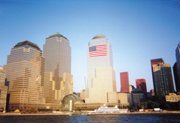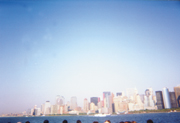

I was born and raised in New York--a lifetime resident of the borough of Queens (one of the city's five boroughs). New York is a gritty, tough but very real place with a strong sense of itself. The maxim goes: "If you are happy with who and what you are, stay where you are, if not: go to New York City and chase your dream."
Many dreams were shattered that horrific day in late summer by a cowardly, barbaric act of terrorism. Fear not, New York will rebuild and reclaim what was materially lost in the form of buildings and infrastructure. New York is forever reshaping and reinventing itself (that's why there's the word "New" in its name). It is the souls of the multitude of innocent victims--our fellow Americans--that can never be replaced.
Getting personal
From my 16-plus years as a trade estimator in the New York metropolitan area, on many occasions I bid work in and around the World Trade Center vicinity in Lower Manhattan. The subcontracting firm I went to work for straight out of college in the mid-'80s, Circle Industries Corp., had been the prime drywall and carpentry contractor when the twin towers were built in the early '70s. The project was so large and complex, Circle formed a subsidiary company to handle the project exclusively. Frequently, in the intervening years, I have bid tenant work in both towers (most recently, the Fiduciary Trust Co. located in the south tower on floors 88, 89 and 90). Most of its employees perished in the attack on the towers.The twin towers of the World Trade Center required special consideration when bidding. First, since the truck bombing in 1993, security was extremely tight. Of course, this had adverse effects on labor production, manpower, handling and the distribution of materials. Being 1/4 mile high in the sky (110 floors each), additional time was needed to load materials due to the extreme verticality of the buildings. I vividly recall being on the observation deck of the south tower and having the sensation of being in an airplane--only standing still on a relatively narrow platform in what seemed to be mid-air.
The structural system of the towers was a "rigid tube" that allowed the building to "bend with the wind" much like a large tree does (up to 10 feet laterally). Being exposed to the bay and ocean beyond, wind shear on the towers could be quite severe--particularly in the winter months and at higher elevations. You could actually feel the building moving in a high wind. The sensation was very similar to being stuck in traffic at mid-span on a suspension bridge. This movement due to wind shear made it practically impossible to use a laser-level in either of the two towers for lay-out work.
Both the residential and commercial areas of Battery Park City (aka World Financial Center), are directly across from the WTC; on the riverside of West Street. In the '80s--and well into the '90s--I bid many of those large, complex projects. The enormity of the catastrophe taking place in Lower Manhattan really hit home later that day when I saw Seven World Trade Center (a 47-story office building adjoining the two towers) collapse after fires burned out of control all day after the planes impacting the towers set it on fire. This building was the first large-scale office building I bid and won for Circle (for the core and shell work).
I take great pride in my work as an estimator; I truly feel that I am taking part in the process of creating the built environment in a fundamental and very relevant way. Seeing that building collapse was a heart-wrenching experience, considering my personal involvement in its construction.
Bring out the best
Adversity and tragedy tends to bring out the humanity in us hard-boiled New Yorkers. I was filled with pride as I watched the news coverage (on the one station left broadcasting: the TV broadcast antenna was atop the north tower). Very many of the building trade unions and their membership selflessly volunteered en masse--risking both life and limb--to assist in the search for victims and the clearing of the mountains of debris and twisted metal, much of it containing bodies or body parts. As well, many private contracting firms donated heavy equipment to further assist the relief efforts.I am part of the construction industry here in New York. Seeing this selfless spirit of cooperation and concern among my peers lifted my spirit and made what was a very bad day just a little bit better. It filled me with hope and tremendous pride in being a native New Yorker and an American. Like many other New Yorkers who wanted to help, I went to a local hospital and offered to donate blood--it was all we could do.
At the time of the attack, I had just finished reading a book entitled, "Flags of Our Fathers." It is about the six men who raised the flag atop Mount Suribachi during the battle for Iwo Jima. It was an inspiring book describing the sacrifice and suffering of the generation of young Americans who fought for our freedom against tyranny and oppression during World War II. These six men, five marines and one navy corpsman, were a composite picture of that entire generation. The battle for Iwo Jima was the most brutal, merciless battle of the Pacific campaign. One third of all Medals of Honor awarded to the Marine Corps in World War II were won in just a few weeks of fighting in February and March of 1945 on that volcanic rock. Admiral Chester Nimitz summed up the heroism and self-sacrifice of these young men with just a few memorable words: "Uncommon valor was a common virtue."
On Sept. 11, 2001, in the canyons of Lower Manhattan Island, that same spirit of courage, self-sacrifice and resolve of purpose was witnessed by the world. To the scores of rescue workers, both living and dead, on that day too: uncommon valor was a common virtue.



Report Abusive Comment